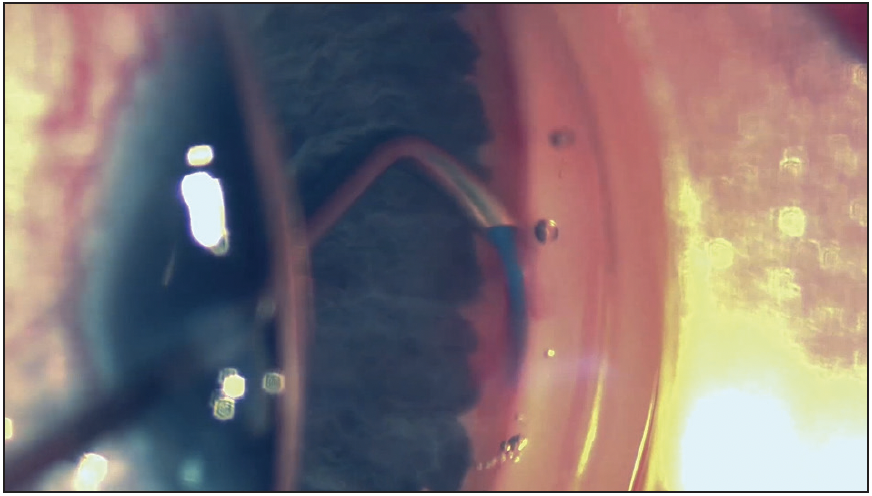A 72-year-old man presented with moderate primary open-angle glaucoma about 5 years ago. At that time, his IOP was 23 mm Hg, and he was on two medications. The patient underwent combined phacoemulsification with a trabecular meshwork bypass stent. Postoperatively, his IOP reduced to 15 mm Hg with two medications but rose to 18 mm Hg when we reduced his medications to one. His IOP remained at 18 mm Hg for approximately 18 months to 2 years. After that time, the patient’s IOP slowly crept up to 21 mm Hg on two medications with evidence of glaucoma progression on OCT.
The patient was very keen about a minimally invasive surgical option and wanted to have the same quick return to daily activities that he experienced after surgery in 2018. A standalone pseudophakic OMNI procedure was planned. During surgery, a 360º viscocanaloplasty without trabeculotomy was successfully performed. The microcatheter was inserted (Figure) between two trabecular bypass stents and slid behind them smoothly with no feeling of obstruction and minimal stent movement. The microcatheter was able to pass through Schlemm’s canal both left and right. The trabecular stents were left in situ because they were believed to be functioning as suggested by the initial IOP reduction in 2018. It was suspected, however, that they may not be fully in canal.
One month after OMNI, the patient’s IOP was 13 mm Hg on one medication. At 6 months, he was off medication completely, and the IOP was 16 mm Hg. At 1 year, the IOP was 17 mm Hg, and the patient remained off any medication.

Figure. The OMNI microcatheter is inserted.
IMPORTANT PRODUCT INFORMATION:
INDICATIONS FOR USE: The OMNI® Surgical System is indicated for the catheterization and transluminal viscodilation of Schlemm’s canal and the cutting of trabecular meshwork to reduce intraocular pressure in adult patients with open-angle glaucoma. For important safety information including contraindications, warnings, precautions and adverse events, please visit omnisurgical.com
Surgeons are paid consultants of Sight Sciences
This information is intended solely for the use of ophthalmic clinicians - Patients should contact their eyecare professional.
OMNI, Sight Sciences, and the Sight Sciences logo are registered trademarks of Sight Sciences, Inc. All other trademarks are the property of their respective owners.
© 2023 Sight Sciences, Inc 6/23 OM-2915-OUS.v1 CE2797

